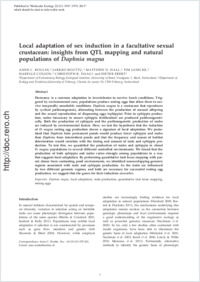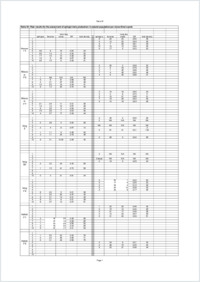Local adaptation of sex induction in a facultative sexual crustacean: insights from QTL mapping and natural populations of Daphnia magna
- Roulin, Anne C. Department of Evolutionary Biology, Zoological Institute, University of Basel, Switzerland
- Routtu, Jarkko Department of Evolutionary Biology, Zoological Institute, University of Basel, Switzerland
- Hall, Matthew D. Department of Evolutionary Biology, Zoological Institute, University of Basel, Switzerland
- Janicke, Tim Department of Evolutionary Biology, Zoological Institute, University of Basel, Switzerland
- Colson, Isabelle Department of Evolutionary Biology, Zoological Institute, University of Basel, Switzerland
- Haag, Christoph R. Department of Ecology and Evolution, University of Fribourg, Switzerland
- Ebert, Dieter Department of Evolutionary Biology, Zoological Institute, University of Basel, Switzerland
-
2013
Published in:
- Molecular Ecology. - 2013, vol. 22, no. 13, p. 3567–3579
English
Dormancy is a common adaptation in invertebrates to survive harsh conditions. Triggered by environmental cues, populations produce resting eggs that allow them to survive temporally unsuitable conditions. Daphnia magna is a crustacean that reproduces by cyclical parthenogenesis, alternating between the production of asexual offspring and the sexual reproduction of diapausing eggs (ephippia). Prior to ephippia production, males (necessary to ensure ephippia fertilization) are produced parthenogenetically. Both the production of ephippia and the parthenogenetic production of males are induced by environmental factors. Here, we test the hypothesis that the induction of D. magna resting egg production shows a signature of local adaptation. We postulated that Daphnia from permanent ponds would produce fewer ephippia and males than Daphnia from intermittent ponds and that the frequency and season of habitat deterioration would correlate with the timing and amount of male and ephippia production. To test this, we quantified the production of males and ephippia in clonal D. magna populations in several different controlled environments. We found that the production of both ephippia and males varies strongly among populations in a way that suggests local adaptation. By performing quantitative trait locus mapping with parent clones from contrasting pond environments, we identified nonoverlapping genomic regions associated with male and ephippia production. As the traits are influenced by two different genomic regions, and both are necessary for successful resting egg production, we suggest that the genes for their induction co-evolve.
- Faculty
- Faculté des sciences et de médecine
- Department
- Département de Biologie
- Language
-
- English
- Classification
- Biological sciences
- License
- License undefined
- Identifiers
-
- RERO DOC 32941
- DOI 10.1111/mec.12308
- Persistent URL
- https://folia.unifr.ch/unifr/documents/303311
Other files
Statistics
Document views: 97
File downloads:
- haa_las.pdf: 188
- haa_las_sm.pdf: 121
- haa_las_sm2.eps: 43


